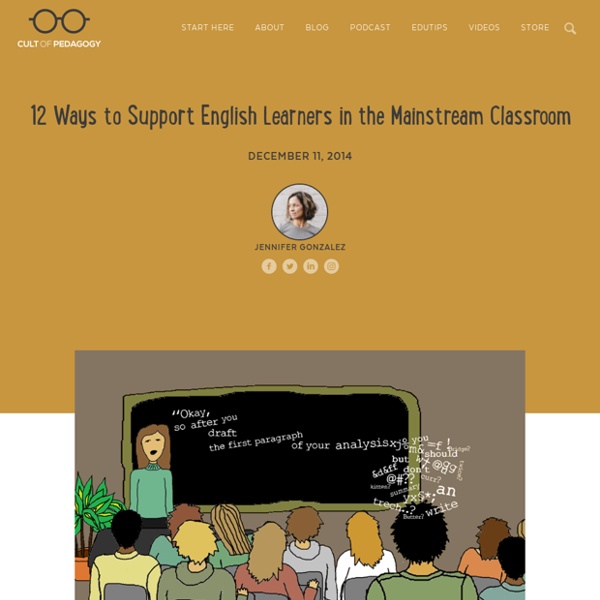



https://www.cultofpedagogy.com/supporting-esl-students-mainstream-classroom/
Related: English Language Learning • MUS 226 • Global Education • ESL • English Language Learner (ELL) Classroom SupportDiversity in Graphic Novels Special thanks to member Laura M. Jiménez for her time and expertise in reviewing and adding additional resources for this blog post. This summer members highlighted the need for more diversity in graphic novels. MTO 21.4: Parsons, Dyslexia and Post-Secondary Aural Skills Instruction Fairness isn’t making sure everyone gets the same thing. Fairness is making sure everyone gets what they need. – Special educator Richard Lavoie (1989) 1.
One and All In a time of division and uncertainty for our country, many of us — teachers, school leaders, parents — are asking, “What can we do?” How can we reject discrimination and protect children who feel targeted for their religion, ethnicity, gender, or even political beliefs? How can we welcome diverse perspectives and hard conversations? CAN DO Descriptors by grade level cluster; download for PreK-K, Grades 1-2, 3-5, 6-8, or 9-12 Look at all we can do! Creating learning environments for language learners based on what they can do! The Can Do Descriptors highlight what language learners can do at various stages of language development as they engage in teaching and learning in academic contexts. WIDA is proud to announce the release of the K–12 Can Do Descriptors, Key Uses Edition, the Early Years Can Do Descriptors (for children 2.5–5.5 years old), and the K–12 PODEMOS, the Spanish Language Development Edition of the Can Do Descriptors.
What is Duolingo? – Duolingo Help Center Last updated: August 10, 2018 Duolingo is the most popular language-learning platform and the most downloaded education app in the world, with more than 300 million users. The company’s mission is to make education free, fun and accessible to all. Add Magic to Read Alouds with Novel Effect In this guest blog post, certified special educator and Chief of Education for Novel Effect Melody Zagami Furze introduces Novel Effect, a free voice interactive storytelling app that can “add music, sounds, and even characters’ voices, simply by reading a book out loud” to enrich the storytelling experience with kids. Lee & Low is excited to have soundtracks for several of our books available now on Novel Effect! As an early childhood educator and now a parent, I know how exhausting it can be to squeeze in all the classroom activities you need in a single day.
Using Music And Rhythm To Develop Grammar Research analyst Allison Aaron and Assistant Professor Reyna Gordon are studying how music and rhythm training could help children who struggle with language development. Their work is part of Vanderbilt's Program for Music, Mind and Society. Kacie Dunham/Courtesy of Reyna Gordon hide caption If You Think Racism is Too Political For Your Classroom, Think About What Your Silence Says Dear Educator, So you’ve tweeted, and retweeted, and shared articles and inspirational quotes, and posted your expressions of disbelief and despair about Charlottesville. I have one question. “What are you going to do now?”
5 super cool short films your ELA students will love – Literature Daydreams I love using short films in my classroom. I bet you already have a collection that you use again and again. Well, me too. W-APT W-APT stands for the WIDA-ACCESS Placement Test. It is an English language proficiency "screener" test given to incoming students who may be designated as English language learners. It assists educators with programmatic placement decisions such as identification and placement of ELLs. The W-APT is one component of WIDA's comprehensive assessment system.
Dia! Diversity in Action – El día de los niños, El día de los libros ALSC Blog Connect with the ALSC Blog to find a collection of articles written about Día by ALSC members and Committees. All Día articles can be accessed at: Romeo and Juliet Romeo and Juliet in dance Like Hamlet, the history of Romeo and Juliet makes for an interesting study of how artistic inspiration is not exclusive to one genre, but is informed by all fields - and how Shakespeare is often a reference point from which this branching out into visual art, music and dance occurs. Romeo and Juliet did not become a part of the standard repertory of dance companies until Serge Prokofiev composed his score around 1935. Prokofiev was probably familiar with Berlioz's dramatic symphony and Tchaikovsky's overture fantasy.